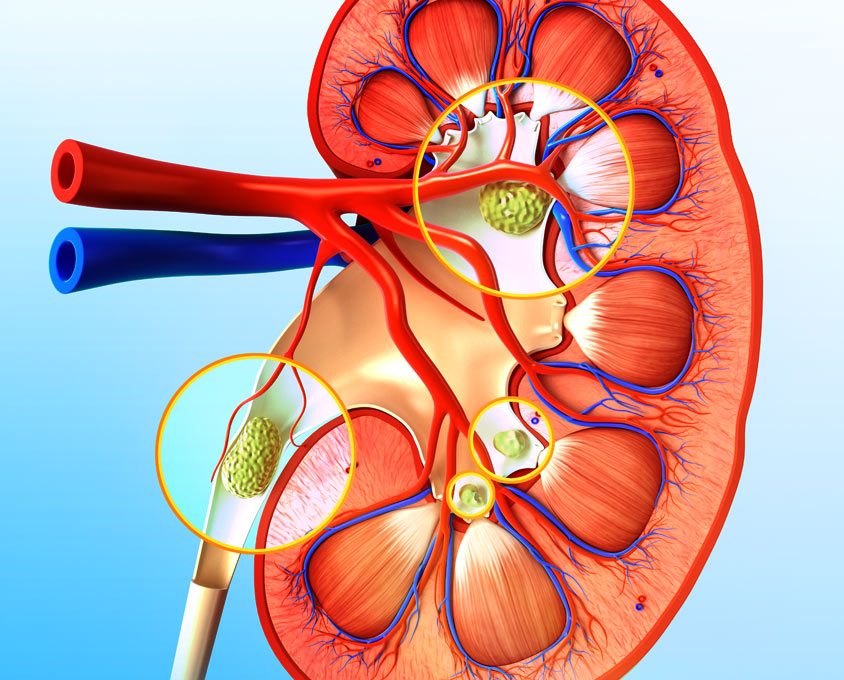What Are Kidney Stones?
Kidney stones initially form inside of the kidney. Sometimes they remain there and other times they travel to different parts of the urinary tract. The typical kidney stone is comprised of uric acid or calcium. They can be as small as the period at the end of a sentence. However, they can also grow to a size of a few inches or even become as large as the kidneys themselves.
How Do Kidney Stones Form?
Your kidneys can form stones when your urine contains too much of certain types of minerals. A lack of proper hydration is a common cause of kidney stones because higher concentrations of minerals get into your urine stream. Slightly less than 10 percent of the population will have at least one kidney stone at some point in their life. These are more common in men than in women. Obesity and diabetes are additional risk factors.
People with small kidney stones may be unaware that they have anything wrong due to no symptoms. The first sign is typically intense pain when the stone moves from the kidney into the ureter. This tube moves urine from your kidneys to your bladder. Despite being very painful, most kidney stones pass through urination and do not require any treatment. If the stones do not pass, you may need to undergo a medical procedure to break these up so that you may pass the stones.

Common Indications of Kidney Stones
Once a kidney stone has passed into your urethra, your body will likely give you several clues as to what is happening. The most common symptoms associated with kidney stones include:
- Back, belly, or side pain: These are the most common places on the body to feel pain when you have a kidney stone. It typically starts very suddenly and can also change in intensity as well as migrate to different parts of your body. The waves of pain are from contractions as your body tries to push the stone out.
- Bloody urine: The medical name for blood appearing in the urine is hematuria. You may notice blood that appears red, pink, or brown.
- Burning or painful urination: When the stone reaches the intersection of your bladder and urethra, it will cause some type of painful urination. Burning pain is the most common, but some people report sharp pain as well.
- Fever and/or chills: These can be signs of a kidney infection or something even more serious. You should always seek immediate medical attention if you have a high fever and strong pain at the same time.
- Nausea and/or vomiting: You may feel nauseous from the intense pain of kidney stones, which can eventually lead to vomiting. When a stone forms in the kidneys, it stimulates nerves in your gastrointestinal tract that starts this process in motion.
- Urine appears cloudy or has an unpleasant odor: When you are healthy, your urine should come out clear and not have much of a smell to it. Urine that looks cloudy or smells foul could indicate kidney stones, but it could also mean that you have a urinary tract infection. You need to visit your doctor to find out for sure.
- Urinary frequency: You will notice that you need to use the bathroom more often once the kidney stone has made it to the lower portion of your urinary tract. Although it feels like you need to urinate immediately, you may find that very little urine comes out when you make it to the toilet. The urgency can even wake you up several times during the night to use the bathroom.
When to Seek Emergency Care
It is important to see your doctor as soon as you can if you recognize any of the above symptoms. However, some symptoms are serious enough that you should report to the emergency department of United Hospital Center (UHC) right away. These include:
- Bloody urine
- Difficulty urinating
- Chills, fever, nausea, or vomiting accompanied by pain
- Intense pain to the point you can’t get comfortable
While we hope you never experience kidney stones, UHC is here to help you to get through these.
Please note, the information provided throughout this site is not intended or implied to be a substitute for professional medical advice, diagnosis or treatment. All content, including text, graphics, images, and video, on or available through this website is for general information purposes only. If you are experiencing related symptoms, please visit your doctor or call 9-1-1 in an emergency.